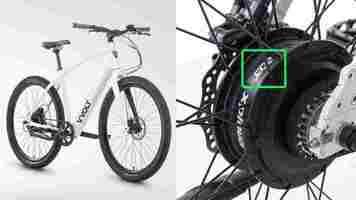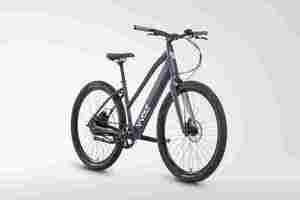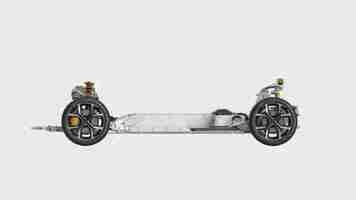Vvolt launches $1399 ebikes with a motor made by… Acer?
Here at TNW, we’ve written a lot about ebikes and a lot about Acer, but not about any ebikes powered by Acer components. As it turns out, Acer recently began making motors via its cycling sub-brand Xplova, and a new ebike company named Vvolt will be the first to bring these motors to the US in two of its four launch models.

Acer partnership aside, Vvolt’s bikes look like welcome additions to the American ebike market. The company’s bikes are designed with reasonable prices and durability in mind — the bikes start at $1,399 and each use belt drives — without sacrificing ride quality. There are a number of sensible design choices. Even the frames are original designs too.
While I normally avoid writing about ebikes from new companies without having at least ridden a prototype, Vvolt is different in that it is one of the rare ebike startups not launching via a crowdfunding campaign.
The Portland, Oregon-based company has secured funding through more traditional means; it’s made up of many of the same folks behind cycling apparel company Showers Pass . The bikes are already in production and the company plans to start shipping bikes in late August. Notably, the company wants to prove it’s here to stay by offering a three-year warranty that includes the electronic components. Most ebike companies only offer a one-year warranty.
And they’re some pretty interesting bikes too.
On the more affordable end of the price spectrum are the Alpha and Alpha S models, the latter being the step-through variant that’s easier to get a leg over. Both modelscost $1,399 and offer a solid selection of specs, most notably the aforementioned 350W Acer/Xplova rear hub motor and Gates CDN belt drive.


The Gates belt drive is known for lasting several times longer than a chain, being virtually silent, making for a maintenance-free experience. The Alpha bikes are single speed models, as the motor means gears are less necessary for dealing with hills.
The bike also offers a 375Wh battery with LG cells that is removeable but sleekly integrated into the frame. It’s a more stealthy setup than most ebikes, and Vvolt claims the battery is good for up to 60 miles on a charge. The bike weighs 44-46 pounds depending on the frame size, and comes with 2-inch wide 650B (27.5″) tires that offer a bit more air volume and cushioning over traditional 700C tires.
Although the Alpha and Alpha S only use a cadence sensor (as opposed to a more advanced torque sensor ), Vvolt tells me the Acer has tuned power delivery to be smooth using just the cadence information. The bike goes up to 20mph and offers 45 Nm of torque, by the way.
The bikes allow for five levels of pedal assist, which can be further tweaked via a Bluetooth app, and a USB port on the display can power the rechargeable lights. I’d much rather these lights be wired to directly to the controller, but at least they’re included.
Moving up the lineup are the Proxima ($2,599) and Sirius ($2,699), both of which use mid-drive motors , offer torque sensing, and come with step-less internally geared hubs. The main difference between them is that the Proxima offers a 100mm air-sprung suspension fork for handling rougher terrain.
Both models use a mid-drive motor by Taiwanese company MPF. This 250W (500W peak) motor offers up to 80 Nm of torque, which should be enough to help you climb any hill and — if the specs hold up — is comparable to motors from big names like Bosch and Yamaha. This motor is a torque-sensing design too, which will hopefully mean a more responsive ride.
The MPF motor is little known stateside but Vvolt says built up a reputation for reliability thanks to its steel, self-lubricating gears (you’d be surprised by the number of motors that use plastic components).
Speaking of gears, the Proxima and Sirius use the fancy Enviolo internally geared hub. As opposed to the traditional derailleur you’d find on most bikes, these gears don’t have ‘steps’ and you can shift whether you are pedaling, or stopped. They’re also known to be incredibly durable, needing only an oil change after several thousand miles. It also offers a wide 380% gear ratio.
The biggest difference between the two mid-drive bikes is that the Sirius offers an air-sprung 100mm suspension fork, and the Proxima is the only model in the lineup to use 700C tires. The Proxima weighs in at 50-52 pounds, while the Sirius weighs in at 54-56 pounds.
There’s a whole lot to like here. For the Alphas, at $1,399 you’d be hard-pressed to find another bike that has a Gates Carbon Belt, hydraulic disk brakes, and a 3-year warranty. The Ride1Up Roadster is a good deal lighter (35lb) and cheaper ($1,045), but uses a non-carbon belt and only offers mechanical rim brakes and a 1-year warranty. The battery is also smaller and not-removeable.
The mid-drive models are simply some of the most affordable mid-drive bikes I’ve seen. Let alone among those with a torque sensor, Gates Carbon Drive, and 80 Nm of torque.
The one asterisk to the price is that fenders and racks do not appear to be included, but the bikes do at least include mounting points for these. The batteries are also a little smaller than some other options on the market, but the bikes are also lighter and less conspicuous than most of the competition with larger batteries. Given the motors aren’t claiming ridiculous power specs, range should still be reasonable.
The company isn’t stopping with these four models either. It also teased a more futuristic-looking bike known as the ‘Bike V’ coming 2020, which will offer some extra functionality thanks to front and rear mounts for racks and baskets, integrated lighting (yay!) and the option of a second battery (which is a very good idea ). A smaller 20-inch wheel up front helps stabilize cargo by lowering the center of gravity.
Credit: Vvolt
Further down the road, the company teased a cargo trike dubbed the Beluga, although Vvolt notes that it is currently a concept on the drawing board.
I wish more ebike companies (and tech companies in general) would launch this way. Crowdfunding has its place, but it too often leads to consumers getting burned. Of course, t he proof is now in the pudding, which I’ll get to ‘taste’ when I test the bikes in the coming weeks. I’d advise waiting until there are third-party impressions of the bikes before spending your heard-earned money, but if the bikes caught your eye, the company is taking pre-orders with a $300 deposit over at Vvolom .
Yes, you can actually buy this badass electric Batmobile
Good news, Batman lovers! A fully functional Batmobile replica exists — and you can even drive it outside of Gotham City.

Led by architect and artist Nguyen Dac Chung, the Vietnam-based Macro Studios used blueprints from Christopher Nolan’s Dark Knight trilogy to faithfully recreate the movie’s Tumbler vehicle .
The result? A replica that’s the spitting image of Batman’s iconic beast. But that’s not all, it also comes with an eco-friendly twist: it’s electric.
Without further ado, I present to you the Dark Green Knight:


And to get a full picture, here are both the Tumbler and the e-Tumbler:
Weighing just 600kg, the electric Tumbler features the same tubular steel chassis as the original, but replaces its bulky metal bodywork with lightweight panels made of ABS plastic, carbon fiber, and composite.
This makes the EV nearly four times lighter than its 2,268-kilo on-screen twin, which, in turn, helps with acceleration.
Speaking of speed, the 500hp 5.7-liter V-8 found in Batman’s original Tumbler has given way to an electric powertrain and a pair of lithium-ion batteries that should allow the car to reach a rather unimpressive 65mph.
There’s no info on the range yet, but I hope to God it’ll be enough to outrun the Joker and the Scarecrow.
The electric six-wheeler also comes with automatic sliding doors, four safety cameras, and monitors.
Plus, you can bring a passenger along. Think of them as a sidekick, your very own Robin.
On the downside, the car doesn’t have an Attack Mode capability, nor the machine guns and the rocket launcher of the original. But, come on, people, it’s an actual e-Batmobile and THAT’S ALL THAT MATTERS.
The prototype is currently on display at the Van Daryl automotive gallery in Ho Chi Minh City. And yes, pre-orders are live.
There’s no word on the price yet, but I imagine I’d need to sell some organs to be able to buy it.
Until that happens, at least I can find some comfort with this teaser:
How Polestar is using blockchain to increase transparency
Annual car sales are unlikely to reach pre-COVID-19 levels anytime soon. In fact, experts say that the rate of recovery is forecasted to be a result of a slowdown in internal combustion engine (ICE) vehicles, with electric vehicles gaining a positive trajectory during the pandemic recovery period and beyond. According to a recent Deloitte study , EVs are likely to secure 32% of the global market share for new car sales by 2030.

More electric vehicles! Sounds great for the environment, right? Yes, but electric car manufacturers have to tread carefully. More EVs means more batteries, and it’s essential that companies source the raw materials needed for batters ethically, particularly cobalt.
Tracing cobalt on the blockchain
Polestar , a recent EV launch, was the first car to announce the use of blockchain to trace cobalt in its batteries, according to Polestar’s Head of Sustainability Frederika Klarén. You might have heard about blockchain in the context of cryptocurrency, like Bitcoin. But blockchain’s uses can extend far beyond digital currency and into the realm of sustainable supply chain management.
Polestar, a brand that advocates for transparency and accountability in the electric vehicle manufacturing industry, believes in the potential of blockchain technology to validate the ethical production of its batteries.
Blockchain records a digital register of transactions within a supply chain that cannot be altered. This transparent traceability means that the sources of the materials, and the methods by which they’re extracted, processed, and transported can be regulated. It’s truly setting the precedent for sustainable supply chain management.
Improving mining conditions
Cobalt is an important resource for battery production. The element helps keep lithium batteries cool during charging and discharging, but obtaining cobalt often presents terrible conditions for miners, particularly in the Republic of Congo.
Earlier this year, reporters uncovered how an army of 35,000 children was mining cobalt in toxic conditions , sparking debates between consumers and manufacturers of electronic products focused on finding a way to improve the situation.
“It was important to us to start with cobalt when piloting this innovative technology. We need many tools to fight the cobalt supply chain risks relating to child- and human rights violations. Supporting communities through programs such as Better Mining, increasing the use of recycled content, and implementing responsible sourcing practices are some of them. And now we can also add blockchain to the list,” said Klarén.
Last year, Polestar worked out an agreement with its two battery suppliers, CATL from China and LG Chem from South Korea, to ensure the cobalt used in its batteries is globally traceable using blockchain technology. Polestar’s blockchain for tracking the life cycle of its cobalt will collect data on the origin, size, weight, chain of custody, and information showing adherence to OECD supply chain guidelines.
Ambitious goals
By guaranteeing that the information in the transaction records cannot be changed without detection, the process improves the scrutiny of the supply chain and demonstrates that vehicle manufacturers can and should only rely on materials that are sourced responsibly and ethically.
Polestar’s sustainability goals are ambitious. In the future, the company hopes to gain more accurate results regarding the carbon footprint and ethical considerations of materials included in the production of its batteries by obtaining data directly from the suppliers. Currently, Polestar is using data gathered from the International Material Data System, a dataset that contains information on material compositions of vehicle components.
“Given the relatively large carbon footprint from the battery, increased collaboration with battery suppliers should be prioritized,” authors of the LCA wrote.
Ambitious goals, yes. But in order to see sustainable progress in the electric vehicle industry in particular, and the automotive industry in general, companies need to make transparency and sustainability a priority.